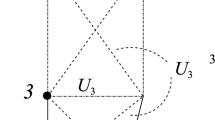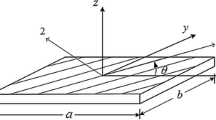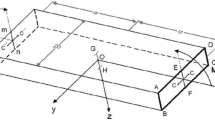The free edges of layered structures require special attention in design processes. Due to the discontinuous material properties, singular stress concentrations occur where the layer interfaces meet the free edge. These bi-material points have to be closely examined as possible starting points for delamination processes. In the present study, we propose an efficient approximate closed-form method to analyze the interlaminar shear stresses in symmetric angle-ply laminates under uniform axial extension and homogeneous thermal loading. The method bases on a higher-order layerwise displacement approach. The resulting displacement and stress distributions of a first-order and a third-order analysis are compared and validated against numerical reference data gained by a self-developed finite element formulation. Especially, the results of the third-order analysis show a good agreement to the reference data along the interface, even if the singular behavior of the stresses in the very close vicinity of the free-edge cannot be reproduced exactly. A comparison of the displacement and stress distributions in thickness direction shows the benefit of the third-order over the first-order approach. In addition, the influence of the ply angle on the results is reproduced by both approaches.









Similar content being viewed by others
References
T. Hayashi, “Analytical study of interlaminar shear stresses in laminated composite plate,” Transactions of the Japan Society of Aeronautical Engineering and Space Science, 10, 43-48 (1967).
S. Dölling, “Eine Erweiterung der Skalierte-Rand-Finite-Elemente-Methode zur Analyse und Bewertung des Randeffekts in ebenen Laminaten mithilfe der Finiten Bruchmechanik,” „“PhD thesis, Technische Universität Darmstadt (2022).
C. Mittelstedt und W. Becker, “Free-edge effects in composite laminates,” Appl. Mech. Reviews, 60, No. 5, 217-245 (2007).
C. Mittelstedt, W. Becker, A. Kappel, and N. Kharghani, “Free edge effects in composite laminates - A review of recent developments 2005-2020,” Appl. Mech. Reviews, 74, No. 1 (2022).
C. Mittelstedt und W. Becker, “Interlaminar stress concentrations in layered structures: Part I-a selective literature survey on the free-edge effect since 1967,” J. Compos. Mater., 38, No. 12, 1037-1062 (2004).
T. Kant and K. Swaminathan, “Estimation of transverse/interlaminar stresses in laminated composites-a selective review and survey of current developments,” Compos. Struct., 49, No. 1, 65-75 (2000).
J. N. Reddy and D. H. Robbins Jr, “Theories and computational models for composite laminates,” Appl. Mech. Reviews, 47, 147-169 (1994).
C. T. Herakovich, “Free edge effects in laminated composites,” Failure in Composites, 4, 205-219 (1989).
N. J. Pagano, Interlaminar Response of Composite Materials, Elsevier, Amsterdam, New York (1989).
N. J. Pagano and S. R. Soni, “Models for studying free-edge effects,” Compos. Mater. Series, 5, 1-68 (1989).
S. R. Soni and N. J. Pagano, “Elastic response of composite laminates,” in: Z. Hashin and C. T. Herakovich, Mechanics of Composite Materials, 227-242, Pergamon, New York (1983).
N. J. Salamon, “An assessment of the interlaminar stress problem in laminated composites,” J. Compos. Mater., 14, No. 1, 177-194 (1980).
A. H. Puppo and H. A. Evensen, “Interlaminar shear in laminated composites under generalized plane stress,” J. Compos. Mater., 4, No. 2, 204-220 (1970).
N. J. Pagano and R. B. Pipes, “The influence of stacking sequence on laminate strength,” J. Compos. Mater., 5, No. 1, 50-57 (1971).
N. J. Pagano and R. B. Pipes, “Some observations on the interlaminar strength of composite laminates,” Int. J. Mech. Sci., 15, No. 8, 679-688 (1973).
A. Harris and O. Orringer, “Investigation of angle-ply delamination specimen for interlaminar strength test,” J. Compos. Mater., 12, No. 3, 285-299 (1978).
P. Conti, P. and A. De Paulis, “A simple model to simulate the interlaminar stresses generated near the free edge of a composite laminate,” in: W. S. Johnson, Delamination and Debonding of Materials, 35-51, American Society for Testing and Materials, Philadelphia (1985).
N. J. Pagano, “On the calculation of interlaminar normal stress in composite laminate,” J. Compos. Mater., 8, No. 1, 65-81 (1974).
W. Becker, “Closed-form analysis of the free edge effect in angle-ply laminates,” J. Appl. Mech., 61, 209-211 (1994).
W. Becker, “Closed-form solution for the free-edge effect in cross-ply laminates,” Compos. Struct., 26, No. 1-2, 39-45 (1993).
W. Becker, “Free-edge stress concentration in angle-ply laminates,” Archive of Appl. Mech., 65, No. 1, 38-43 (1994).
W. Becker and G. Kress, “Stiffness reduction in laminate coupons due to the free-edge effect,” Compos. Sci. and Technol., 52, No. 1, 109-115 (1994).
R. B. Pipes and N. J. Pagano, “Interlaminar stresses in composite laminates—an approximate elasticity solution,” J. Appl. Mech., 41, No. 3, 668-672 (1974).
G. Kress and W. Becker, “Effective tensile stiffness of finite-width quasi-isotropic laminates,” J. Reinf. Plastics and Compos., 14, 1043-1053 (1995).
C. Zhu and Y. C. Lam, “A Rayleigh-Ritz solution for local stresses in composite laminates,” Compos. Sci. Technol., 58, No. 3-4, 447-461 (1998).
M. Tahani and A. Nosier, “Free edge stress analysis of general cross-ply composite laminates under extension and thermal loading,” Compos. Struct., 60, No. 1, 91-103 (2003).
C. Mittelstedt and W. Becker, “Fast and reliable analysis of free-edge stress fields in a thermally loaded composite strip by a layerwise laminate theory,” Int. J. Numerical Methods in Eng., 67, No. 6, 747-770 (2006).
C. Mittelstedt and W. Becker, “The Pipes–Pagano-problem revisited: elastic fields in boundary layers of plane laminated specimens under combined thermomechanical load,” Compos. Struct., 80, No. 3, 373-395 (2007).
C. Mittelstedt and W. Becker, “Reddy’s layerwise laminate plate theory for the computation of elastic fields in the vicinity of straight free laminate edges,” Mater. Sci. and Eng., 498, No. 1-2, 76-80 (2008).
G. Flanagan, “An efficient stress function approximation for the free edge stresses in laminates,” Int. J. of Solids and Struct., 31, No. 7, 941-952 (1994).
C. Kassapoglou and P. A. Lagace, “An efficient method for the calculation of interlaminar stresses in composite materials,” J. Appl. Mech., 53, 744-750 (1986).
C. Kassapoglou and P. A. Lagace, “Closed form solutions for the interlaminar stress field in angle-ply and cross-ply laminates,” J. Compos. Mater., 21, No. 4, 292-308 (1987).
C. Kassapoglou, “The effect of combined loading and stacking sequence on the interlaminar stress field at free edges of composite laminates,” 30th AIAA/ASME/ASCE/AHS/ASC Structures, Structural Dynamics and Materials Conference: A Collection of Technical Papers, 4, 2089-2097 (1989).
S. K. Morton and J. P. H. Webber, “Interlaminar failure due to mechanical and thermal stresses at the free edges of laminated,” Compos. Sci. and Technol., 47, 1-13 (1993).
C. A. Rose and C. T. Herakovich, “An approximate solution for interlaminar stresses in composite laminates,” Compos. Eng., 3, No. 3, 271-285 (1993).
C. C. Lin, C. Y. Hsu, and C. C. Ko, “Interlaminar stresses in general laminates with straight free edges,” AIAA J., 33, No. 8, 1471-1476 (1995).
S. Tang, “A boundary layer theory — Part I: Laminated composites in plane stress,” J. Compos. Mater., 9, 33-41 (1975).
S. Tang and A. Levy, “A boundary layer theory — Part II: Extension of laminated finite strip,” J. Compos. Mater., 9, No. 1, 42-52 (1975).
P. Bar-Yoseph and T. H. Pian, “Calculation of interlaminar stress concentration in composite laminates,” J. Compos. Mater., 15, No. 3, 225-239 (1981).
P. Bar-Yoseph, “On the accuracy of interlaminar stress calculation in laminated plates,” Computer Methods in Appl. Mech. and Eng., 36, 309-329 (1983).
N. J. Pagano, “Stress fields in composite laminates,” Int. J. of Solids and Struct., 14, No. 5, 385-400 (1978).
N. J. Pagano, “Free edge stress fields in composite materials,” Int. J. Solids and Struct., 14, 401-406 (1978).
N. J. Pagano and S. R. Soni, “Global-local laminate variational model,” Int. J. Non-linear Mech., 14, 207-228 (1983).
P. N. Harrison and E. R. Johnson, “A mixed variational formulation for interlaminar stresses in thickness-tapered composite laminates,” Int. J. of Solids and Struct., 33, No. 16, 2377-2399 (1996).
E. R. Johnson and B. L. Kemp, “Modeling the stress field in laminated composite plates near discontinuities,” Compos. Struct., 3, No. 2, 145-166 (1985).
A. Diaz Diaz, J. F. Caron, and R. P. Carreira, “Software application for evaluating interfacial stresses in inelastic symmetrical laminates with free edges,” Compos. Struct., 58, No. 2, 195-208 (2002).
N. J. Pagano, G. A. Schoeppner, R. Kim, and F. L. Abrams, “Steady-state cracking and edge effects in thermo-mechanical transverse cracking of cross-ply laminates,” Compos. Sci. and Technol., 58, No. 11, 1811-1825 (1998).
S. G. Lekhnitskii, Theory of Elasticity of an Anisotropic Elastic Body, Holden-Day, San Francisco (1963).
C. Hwu, Anisotropic Elastic Plates, Springer, New York (2010).
T. Lorriot, G. Marion, R. Harry, and H. Wargnier, “Onset of free-edge delamination in composite laminates under tensile loading,” Compos., Part B, 34, No. 5, 459-471 (2003).
E. Martin, D. Leguillon, and N. Carrère, “A twofold strength and toughness criterion for the onset of free-edge shear delamination in angle-ply laminates,” Int. J. of Solids and Struct., 47, No. 9, 1297-1305 (2010).
N. Schneider, “Entwicklung eines Finiten Elementes für den Laminatrandeffekt,” Master thesis, TU Darmstadt (2019).
S. S. Wang and I. Choi, “Boundary-layer effects in composite laminates: Part 1: Free-edge stress singularities,” J. Appl. Mech., 49, No. 3, 541-58 (1982).
S. S. Wang and I. Choi, “Boundary-layer effects in composite laminates: Part 2 — Free-edge stress solutions and basic characteristics,” J. Appl. Mech., 49, No. 3, 549-560 (1982).
S. Dölling, J. Hahn, J. Felger, S. Bremm, and W. Becker, “A scaled boundary finite element method model for interlaminar failure in composite laminates,” Compos. Struct., 241, 111865 (2020).
C. Frey, S. Dölling, M. Leštáková, and W. Becker, “Free-edge crack onset induced by thermal loading,” Int. J. of Solids and Struct., 230-231, 111160 (2021).
A. D. Diaz and J. F. Caron, “Prediction of the onset of mode III delamination in carbon-epoxy laminates,” Compos. Struct., 72, No. 4, 438-445 (2006).
C. T. Herakovich, “On the relationship between engineering properties and delamination of composite materials,” J. Compos. Mater., 15, No. 4, 336-348 (1981).
C. Frey, S. Dölling, and W. Becker, “Closed-form analysis of interlaminar crack initiation in angle-ply laminates,” Compos. Struct., 257, 113060 (2020).
C. Frey, S. Dölling, and W. Becker, “Free-edge delamination in composite laminates under tensile loading: An analytical closed-form approach,” PAMM: Proc. in Appl. Math. and Mech., 20, No. 1 (2021).
C. Frey, S. Dölling, and W. Becker, “A general sandwich-type model for delamination failure in angle-ply laminates under thermo-mechanical loading,” PAMM: Proc. in Appl. Math. and Mech., 21, No. 1 (2021).
T. Hughes, The Finite Element Method: Linear Static and Dynamic Analysis, Prentice-Hall, New Jersey (1987).
M. Hahn and M. Reck, Kompaktkurs Finite Elemente für Einsteiger, Springer, Wiesbaden (2018).
Author information
Authors and Affiliations
Corresponding author
Appendices
Appendix A. Boundary conditions of the proposed models at the free edge y = 0 and at the symmetry plane y = b.
For FSDT model: | y = 0 | y = b |
|---|---|---|
\({N}_{xy}^{\left(1\right)}+\frac{2}{t}{M}_{xy}^{\left(2\right)}=0\) | \({\widehat{u}}_{x}^{\left(1\right)}=0\) | |
\({N}_{xy}^{\left(2\right)}-\frac{2}{t}{M}_{xy}^{\left(2\right)}=0\) | \({\widehat{u}}_{x}^{\left(2\right)}=0\) | |
\({N}_{yy}^{\left(1\right)}+\frac{2}{t}{M}_{yy}^{\left(2\right)}=0\) | \({\widehat{u}}_{y}^{\left(1\right)}=0\) | |
\({N}_{yy}^{\left(2\right)}-\frac{2}{t}{M}_{yy}^{\left(2\right)}=0\) | \({\widehat{u}}_{y}^{\left(2\right)}=0\) | |
\({M}_{xy}^{\left(1\right)}-{M}_{xy}^{\left(2\right)}=0\) | \({\psi }_{x}^{\left(1\right)}=0\) | |
\({M}_{yy}^{\left(1\right)}-{M}_{yy}^{\left(2\right)}=0\) | \({\psi }_{y}^{\left(1\right)}=0\) | |
For TSDT model: | y = 0 | y = b |
\({N}_{xy}^{\left(1\right)}-{3c}_{2}\left({O}_{xy}^{\left(1\right)}-{O}_{xy}^{\left(2\right)}\right)+{6c}_{3}\left({P}_{xy}^{\left(1\right)}+{P}_{xy}^{\left(2\right)}\right)=0\) | \({\widehat{u}}_{x}^{\left(1\right)}=0\) | |
\({N}_{xy}^{\left(2\right)}+{3c}_{2}\left({O}_{xy}^{\left(1\right)}-{O}_{xy}^{\left(2\right)}\right)-{6c}_{3}\left({P}_{xy}^{\left(1\right)}+{P}_{xy}^{\left(2\right)}\right)=0\) | \({\widehat{u}}_{x}^{\left(2\right)}=0\) | |
\({N}_{yy}^{\left(1\right)}-{3c}_{2}\left({O}_{yy}^{\left(1\right)}-{O}_{yy}^{\left(2\right)}\right)+{6c}_{3}\left({P}_{yy}^{\left(1\right)}+{P}_{yy}^{\left(2\right)}\right)=0\) | \({\widehat{u}}_{y}^{\left(1\right)}=0\) | |
\({N}_{yy}^{\left(1\right)}+{3c}_{2}\left({O}_{yy}^{\left(1\right)}-{O}_{yy}^{\left(2\right)}\right)-{6c}_{3}\left({P}_{yy}^{\left(1\right)}+{P}_{yy}^{\left(2\right)}\right)=0\) | \({\widehat{u}}_{y}^{\left(2\right)}=0\) | |
\({M}_{xy}^{\left(1\right)}+{c}_{2}t\left({O}_{xy}^{\left(1\right)}-{O}_{xy}^{\left(2\right)}\right)-{c}_{3}t\left(7{P}_{xy}^{\left(1\right)}+2{P}_{xy}^{\left(2\right)}\right)=0\) | \({\psi }_{x}^{\left(1\right)}=0\) | |
\({M}_{xy}^{\left(2\right)}+{c}_{2}t\left({O}_{xy}^{\left(1\right)}-{O}_{xy}^{\left(2\right)}\right)-{c}_{3}t\left(2{P}_{xy}^{\left(1\right)}+7{P}_{xy}^{\left(2\right)}\right)=0\) | \({\psi }_{y}^{\left(2\right)}=0\) | |
\({M}_{yy}^{\left(1\right)}+{c}_{2}t\left({O}_{yy}^{\left(1\right)}-{O}_{yy}^{\left(2\right)}\right)-{c}_{3}t\left(7{P}_{yy}^{\left(1\right)}+2{P}_{yy}^{\left(2\right)}\right)=0\) | \({\psi }_{y}^{\left(1\right)}=0\) | |
\({M}_{yy}^{\left(2\right)}+{c}_{2}t\left({O}_{yy}^{\left(1\right)}-{O}_{yy}^{\left(2\right)}\right)-{c}_{3}t\left(2{P}_{yy}^{\left(1\right)}+7{P}_{yy}^{\left(2\right)}\right)=0\) | \({\psi }_{y}^{\left(2\right)}=0\) |
Appendix B. Finite Element Formulation
The matrix \(\overline{\mathbf{B} }\) contains the partial derivatives of the shape functions in an averaged sense. It is given by
where B, Bm and \({\overline{\mathbf{B}} }_{m}\) are given as
The volume-averaged partial derivatives of the shape function are defined as
Using the matrix \(\overline{\mathbf{B} }\) instead of \(\overline{\mathbf{B} }\) prevents the element stiffness matrix from getting singular for nearly incompressible materials [62, 63]. Furthermore, the matrix B0 is given as
Appendix C. Effective Stiffness
The constitutive law of a symmetric laminate under uniform axial strain ε0 in x -direction according to the CLPT is given by
Consequently, this results in
which implicates the definition of the effective longitudinal stiffness for symmetric laminates:
Herein, d is the total laminate thickness and A-1 the inverse of the extensional stiffness matrix of the laminate. For the general case of arbitrary layups with bending extension coupling, (ABD)-1 must be used instead of A-1.
Rights and permissions
Springer Nature or its licensor (e.g. a society or other partner) holds exclusive rights to this article under a publishing agreement with the author(s) or other rightsholder(s); author self-archiving of the accepted manuscript version of this article is solely governed by the terms of such publishing agreement and applicable law.
About this article
Cite this article
Frey, C., Hahn, J., Schneider, N. et al. A Layerwise Higher-Order Approach for the Free-Edge Effect in Angle-Ply Laminates. Mech Compos Mater 59, 299–318 (2023). https://doi.org/10.1007/s11029-023-10097-8
Received:
Revised:
Published:
Issue Date:
DOI: https://doi.org/10.1007/s11029-023-10097-8




